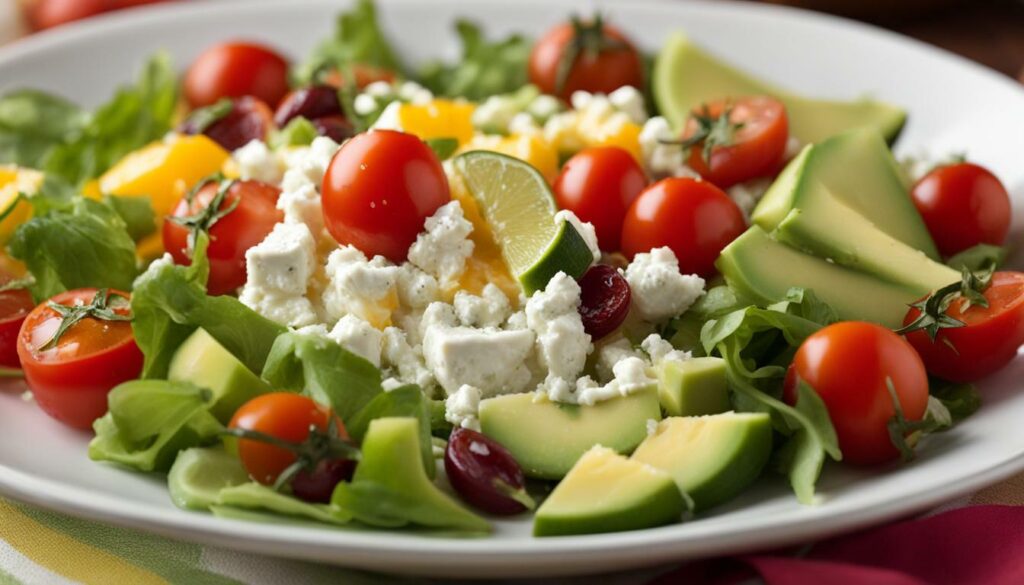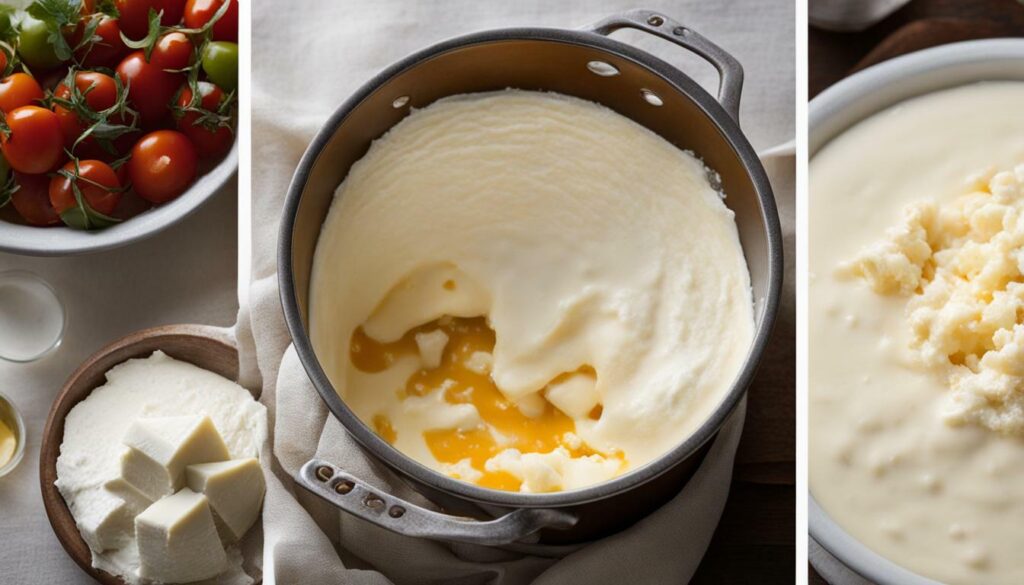Queso fresco is a delightful cheese that has captured the hearts of many in the United States, and understanding its translation and origins can enhance your culinary adventures.
The literal translation of Queso Fresco in English is fresh cheese!
This mild, fresh, and slightly tangy white cheese is a staple in Mexican kitchens, loved for its subtle salty, sour, and milky flavors. Traditionally made with raw cow’s milk or a combination of cow and goat milk, queso fresco provides a unique taste that complements spicy dishes perfectly. In the United States, you can easily find pasteurized versions of this cheese in grocery stores, making it accessible to all.
When it comes to using queso fresco in your kitchen, the possibilities are endless. From topping tacos and enchiladas to crumbling it onto various Mexican dishes, its versatility is unmatched. However, it’s important to note that queso fresco doesn’t melt well due to its soft texture. As a healthier choice, this cheese has lower sodium and fat content compared to aged cheeses, making it suitable for those watching their intake. Pair it with light wines, fruits, or spicy foods to elevate your dining experience.
For those who are curious about making their own queso fresco at home, we’ve got you covered. In the upcoming sections, you’ll find step-by-step instructions to create this cheese from scratch, allowing you to truly connect with its origins and flavors.
Key Takeaways:
- Queso fresco is a mild, fresh, and slightly tangy white cheese.
- Traditionally made with raw cow’s milk or a combination of cow and goat milk.
- Pasteurized versions are commonly found in grocery stores in the United States.
- Queso fresco is a great choice for balancing spicy dishes with its subtle salty, sour, and milky flavors.
- It is commonly used as a topping or stuffing for tacos and enchiladas and can be crumbled onto various Mexican dishes.
- Queso fresco has lower sodium and fat content compared to aged cheeses.
- It pairs well with light wines, fruits, and spicy foods.
Exploring Queso Fresco’s Origins and Characteristics
Contents
- 1 Exploring Queso Fresco’s Origins and Characteristics
- 2 Using Queso Fresco in Your Kitchen
- 3 Pairing and Serving Queso Fresco
- 4 Making Your Own Queso Fresco
- 5 Find out more about Queso Fresco
- 6 Can You Freeze Queso Fresco? Our Guide to Proper Storage
- 7 Is Queso Fresco Healthy? Unveiling the Truth | Our Discovery.
- 8 Oaxaca Cheese vs Queso Fresco: Unveiling the Delicious Mystery
- 9 Queso Fresco Vs Feta: Unveiling the Cheesy Differences
- 10 Discover How to Store Queso Fresco with Our Easy Tips!
- 11 Unraveling the Mystery: Does Queso Fresco Melt?
- 12 Queso Fresco vs Mozzarella: Exploring Cheesy Differences
- 13 Finding the Perfect Substitute for Queso Fresco – Your Guide
- 14 FAQ
- 14.1 Q: What is queso fresco?
- 14.2 Q: How is queso fresco made?
- 14.3 Q: Can I find pasteurized versions of queso fresco in the United States?
- 14.4 Q: How can I use queso fresco in my cooking?
- 14.5 Q: Does queso fresco melt well?
- 14.6 Q: Is queso fresco a healthy choice?
- 14.7 Q: What are some suggested pairings for queso fresco?
- 14.8 Q: How should queso fresco be stored?
Authentic queso fresco is made from raw cow’s milk or a combination of cow and goat milk, which gives it a unique flavor profile. This traditional Mexican cheese is mild, fresh, soft, and slightly tangy, making it a versatile ingredient in various dishes. In the United States, pasteurized versions of queso fresco are widely available in grocery stores, ensuring accessibility for everyone.
The ingredients used to make queso fresco are simple yet essential. Raw cow’s milk or a blend of cow and goat milk is typically combined with rennet, a natural coagulant that helps in the formation of curds. This mixture is then left to rest, allowing the curds to separate from the whey. The curds are collected, lightly salted, and pressed to form the final cheese. The result is a cheese with a slightly salty and tangy taste, perfect for complementing a variety of dishes.
When it comes to nutrition, queso fresco is often a healthier choice compared to aged cheeses. It has lower sodium and fat content, making it suitable for those seeking a lighter option. Despite being a soft cheese, queso fresco does not melt well. However, its crumbly texture is ideal for sprinkling over tacos, enchiladas, salads, and other Mexican dishes, adding a delightful touch to your meals.
What is Queso Fresco in English? Did you know?
Queso fresco is commonly referred to as “fresh cheese” in English, highlighting its mild and young characteristics.
To enjoy the best flavors of queso fresco, it is recommended to pair it with light wines, such as Sauvignon Blanc or Pinot Grigio. Additionally, it goes well with fresh fruits like mangoes, strawberries, and melons, enhancing the cheese’s natural tanginess. For those who crave a little heat, adding queso fresco to spicy foods like chili peppers or salsas can provide a delightful balance to the dish.
Remember, due to its fresh nature, queso fresco is best consumed within 5-7 days. To keep it fresh, store the cheese in vacuum-sealed bags or airtight containers in the refrigerator. This will help maintain its taste and texture until you’re ready to savor it once again.

Now that we’ve explored the origins and characteristics of queso fresco, it’s time to discover how this delightful cheese can elevate your culinary creations. In the next section, we’ll delve into the various ways you can use queso fresco in your kitchen, from classic recipes to innovative substitutes. Get ready to add a touch of cheesy delight to your meals!
Using Queso Fresco in Your Kitchen
Queso fresco is incredibly versatile and can be used in a variety of ways to add a creamy, tangy touch to your favorite dishes. Whether you’re looking to enhance the flavors of tacos, salads, or even desserts, this fresh cheese is sure to elevate your culinary creations. Here are some ideas and tips for incorporating queso fresco into your cooking:
- Top off your tacos: Sprinkle crumbled queso fresco on your favorite tacos for an extra burst of flavor. Its mild taste pairs perfectly with the bold spices and textures of Mexican cuisine.
- Upgrade your salads: Instead of using the usual feta or blue cheese, try adding queso fresco to your salads. Its creamy and tangy profile adds a delightful twist to fresh greens and vegetables.
- Stuff it in peppers: For a delicious appetizer or side dish, stuff queso fresco into roasted peppers. The cheese softens and melts slightly when baked, creating a gooey and irresistible filling.
If you don’t have queso fresco on hand, don’t worry! There are a few substitutes that can work just as well. Panela cheese or feta cheese can be used in place of queso fresco, as they share a similar texture and mild flavor. However, keep in mind that the taste may vary slightly.
So, go ahead and get creative in the kitchen with queso fresco! Its creamy and tangy characteristics make it a fantastic addition to an array of dishes. Experiment with different recipes and combinations to discover your own unique culinary delights.

“These queso fresco-stuffed jalapeno poppers are the perfect appetizer for any party. The melted cheese combined with the spicy kick of jalapenos creates a mouthwatering sensation. Here’s how to make them:
- Cut jalapenos in half lengthwise and remove the seeds.
- Fill each jalapeno half with crumbled queso fresco.
- Wrap the stuffed jalapenos with bacon and secure with toothpicks.
- Grill or bake the poppers until the bacon is crispy and the cheese is melted.
- Serve hot and enjoy the cheesy, spicy goodness!”
With these ideas and recipes, you’re well on your way to exploring the endless possibilities of queso fresco in your kitchen. Let your imagination run wild and savor the creamy, tangy flavors this cheese has to offer.
Pairing and Serving Queso Fresco
Queso fresco pairs wonderfully with light wines, fresh fruits, and bold, spicy flavors, making it a delightful addition to any meal. Its mild and slightly tangy taste complements a variety of dishes, adding a creamy and refreshing element. Whether you’re enjoying a casual taco night or hosting a sophisticated dinner party, queso fresco cheese brings a touch of authenticity to your table.
When it comes to wine pairings, opt for crisp and light selections. A refreshing Sauvignon Blanc or a fruity Rosé will nicely balance the creaminess of the cheese without overpowering its delicate flavors. The acidity in these wines cuts through the richness, creating a harmonious pairing. For a non-alcoholic option, sparkling water with a squeeze of lime will provide a similar effect.
For a refreshing twist, serve queso fresco alongside a platter of fresh fruits. The natural sweetness of fruits like watermelon, pineapple, or mango complements the cheese’s slightly salty profile. The contrasting flavors and textures create a delightful combination that is both light and satisfying.
When incorporating queso fresco into your favorite Mexican dishes, consider these tips. Crumble the cheese over tacos, enchiladas, or salads to add a creamy and tangy element. Its crumbly texture adds a pleasant contrast to the other ingredients. Alternatively, stuff peppers or mushrooms with queso fresco, then bake until melted and slightly golden. The cheese’s mild flavor will enhance the overall taste of the dish.

- Tacos with queso fresco, spicy salsa, and avocado
- Watermelon and queso fresco salad with fresh mint
- Grilled corn with queso fresco and lime
- Stuffed mushrooms with queso fresco and chorizo
Experiment with different flavor combinations and let your creativity shine. Queso fresco is a versatile cheese that adds a touch of authenticity and freshness to any culinary creation. Its subtle flavors and crumbly texture make it a go-to choice for those looking to enhance their meals with a touch of Mexican charm.
Making Your Own Queso Fresco
If you’re feeling adventurous, making your own queso fresco is a rewarding and surprisingly simple process that will elevate your cheese-loving journey. With just a few basic ingredients and some patience, you can create your own delicious queso fresco right at home. Here’s a step-by-step guide to get you started.
- Start by gathering your ingredients: 1 gallon of whole milk, 1/4 cup of white distilled vinegar, and 1 teaspoon of salt.
- Pour the milk into a large pot and slowly heat it over medium-low heat until it reaches a temperature of 185°F (85°C), stirring occasionally to prevent scorching.
- Once the milk reaches the desired temperature, remove it from the heat and slowly stir in the vinegar. You’ll notice the milk starting to curdle and separate into curds and whey.
- Allow the mixture to sit undisturbed for about 10 minutes to allow the curds to fully form.
- Line a colander with cheesecloth and place it over a large bowl or in the sink to catch the whey. Carefully pour the curds into the colander, allowing the whey to drain away.
- Sprinkle the salt over the curds and gently mix it in, ensuring it is evenly distributed.
- Gently gather the corners of the cheesecloth and twist them together to create a bundle. Hang the bundle from a kitchen faucet or handle to allow any remaining whey to drain off for about 1-2 hours.
- Once the whey has fully drained, unwrap the cheesecloth and transfer the queso fresco to an airtight container. It can be stored in the refrigerator for up to a week.
Congratulations! You’ve successfully made your own queso fresco. Now, get ready to enjoy its creamy texture and tangy flavor in your favorite dishes.
Pro Tips:
“For a slightly creamier queso fresco, you can experiment with using a combination of cow and goat milk.”
“Feel free to add some herbs or spices to the cheese during the curdling process to customize the flavor to your liking.”
Remember, making queso fresco at home allows you to be creative and tailor it to your preferences. So, have fun experimenting and savor the satisfaction of creating a homemade cheese that will impress your family and friends.

Queso fresco in English is a beloved cheese choice in American kitchens, offering a mild, tangy flavor that perfectly complements a wide range of dishes. This fresh, soft, and slightly tangy white cheese is a staple in Mexican cuisine, traditionally made with raw cow’s milk or a combination of cow and goat milk. In the United States, you can easily find pasteurized versions of queso fresco in grocery stores, making it accessible to all cheese lovers.
One of the reasons why queso fresco is so popular is its ability to balance the spiciness of Mexican dishes. Its subtle salty, sour, and milky flavors create a harmonious combination when paired with hot and spicy foods. Queso fresco is commonly used as a topping or stuffing for tacos and enchiladas, adding a creamy and tangy element to these classic dishes. You can also crumble it onto salads, quesadillas, or even scrambled eggs for a burst of flavor.
Not only is queso fresco delicious, but it is also a healthier cheese option. It has lower sodium and fat content compared to aged cheeses, making it a great choice for individuals who are conscious of their diet. Additionally, the cheese pairs well with lighter wines and fruits, enhancing the overall dining experience. To ensure its freshness, queso fresco should be consumed within 5-7 days and stored in vacuum-sealed bags or airtight containers.
Now that you know more about queso fresco in English, it’s time to get creative in the kitchen and explore its versatility. Whether you’re topping your favorite Mexican dishes, experimenting with new recipes, or even making your own queso fresco at home, this cheese will undoubtedly add a delightful touch to your meals. So go ahead, indulge in the creamy, tangy goodness of queso fresco and bring a taste of Mexico to your American kitchen!
Find out more about Queso Fresco
FAQ
Q: What is queso fresco?
A: Queso fresco is a mild, fresh, soft, and slightly tangy white cheese that is a staple in Mexican kitchens.
Q: How is queso fresco made?
A: Queso fresco is traditionally made with raw cow’s milk or a combination of cow and goat milk, giving it a slightly salty and tangy taste.
Q: Can I find pasteurized versions of queso fresco in the United States?
A: Yes, pasteurized versions of queso fresco are commonly found in grocery stores in the United States.
Q: How can I use queso fresco in my cooking?
A: Queso fresco is a great choice for topping or stuffing tacos and enchiladas. It can also be crumbled onto various Mexican dishes for added flavor.
Q: Does queso fresco melt well?
A: No, queso fresco does not melt well. It is a soft cheese that retains its shape when heated.
Q: Is queso fresco a healthy choice?
A: Yes, queso fresco has lower sodium and fat content compared to aged cheeses, making it a healthier option.
Q: What are some suggested pairings for queso fresco?
A: Queso fresco pairs well with light wines, fruits, and spicy foods.
Q: How should queso fresco be stored?
A: Queso fresco should be consumed within 5-7 days and stored in vacuum-sealed bags or airtight containers.
